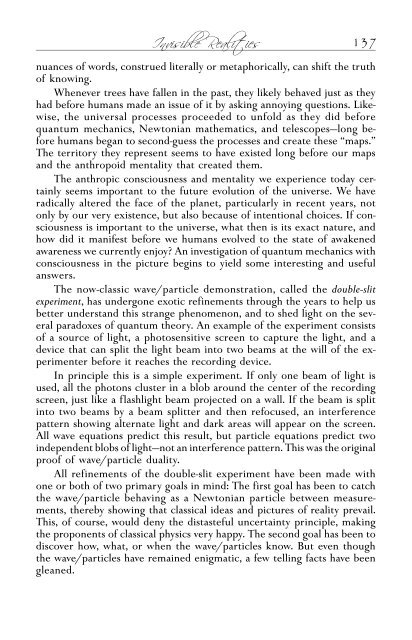edgar-mitchell
edgar-mitchell
edgar-mitchell
You also want an ePaper? Increase the reach of your titles
YUMPU automatically turns print PDFs into web optimized ePapers that Google loves.
Into the Vacuum 69<br />
Though exhausted, rest would be at best fitful, as we had landed on a<br />
slight incline. Always there was the sensation that the lunar module was<br />
about to topple over, due to the slope and the lessened sense of “down.”<br />
With only a sixth of normal gravitation tugging at the fabric of our bodies,<br />
there was the phantom feeling of instability. This led to the tendency of<br />
the imagination to run away with itself, though intellectually we knew<br />
what caused this sensation, and that we were quite stable. But if Antares<br />
did topple over, we would doubtless be stranded on the moon for the rest<br />
of our brief lives, with only a few hours of oxygen and other vital supplies<br />
at our disposal. Such thoughts produced a strange and subtle energy when<br />
it came time to rest. Edgy half-dreams would surface. So we more or less<br />
spent the night listening to the tiny sound of an occasional micrometeorite<br />
colliding with our fragile home, our minds secretly turning over the knowledge<br />
that we were the only two living creatures on this dead world. The<br />
knowledge that survival was not guaranteed mingled with the exhilaration<br />
of being the first to explore this place. Two extraterrestrials asleep in their<br />
spaceship.<br />
When it was time to arise a few hours later, we knew that our day was<br />
centered around a trek to the rim of Cone Crater. We would command a<br />
view that no humans had ever beheld: an ancient lunar crater 750 feet<br />
deep and 1,100 feet across. A general fatigue from sleeplessness was surmounted<br />
by thrilling anticipation. Again, we pulled on our extravehicular<br />
equipment, depressurized the cabin of Antares, and walked into this<br />
strangely lit world where sunlight left black shadows. We then loaded equipment<br />
on the MET, or modular equipment transporter, consulted our checklist,<br />
and set out for the rim of Cone Crater, the summit of which could be<br />
seen on the eastern horizon.<br />
We left Antares surrounded by a cluster of scientific equipment we had<br />
assembled and placed in position, taking with us our MET, the first wheeled<br />
vehicle on the moon. Stone Age technology somehow seemed fitting here:<br />
The MET was a sort of wheelbarrow to be carried backwards, a rickshaw<br />
with a single handle. As we set out for the summit, we would look back<br />
from time to time to see the silvery pair of tire trails leading all the way<br />
back to the spider legs of Antares. When looking toward the sun in the<br />
strange glare of lunar light, the tire tracks looked like the greasy trails of<br />
earthly slugs. The scene as a whole was so otherworldly, at once hauntingly<br />
familiar and unfamiliar.<br />
Embarking on a journey on the moon by foot was a more puzzling<br />
experience than anyone had anticipated, certainly more difficult than could<br />
be imagined by merely studying high-resolution photographs of the surface,<br />
which were what we used to navigate by. Landmarks clearly depicted<br />
on the photographs were obscured by larger than expected undulations of<br />
the cratered surface. This was a terrific surprise. Though the area around


